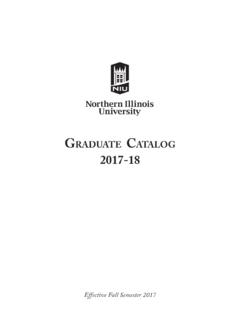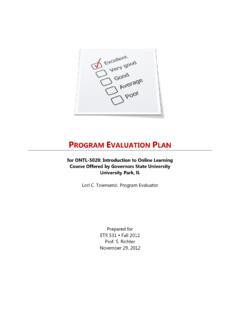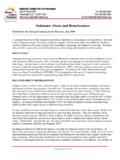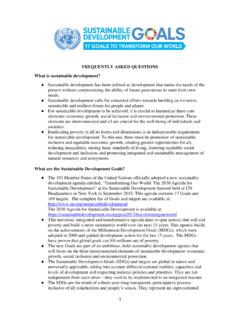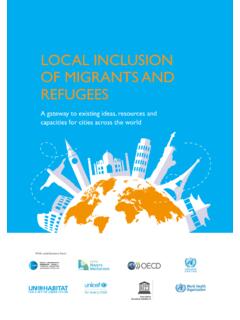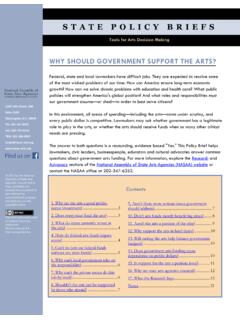Transcription of The Mindanao Conflict and Prospects for Peace in the ...
1 The Mindanao Conflict and Prospects for Peace in the Southern Philippines Excerpted from Mindanao : A Perspective on Youth, Inter-Ethnic Dialogue and Conflict Resolution In the Southern Philippines by Susan D. Russell, Lina Davide-Ong, April Rica Gonzalez, Rey Ty, Nagasura T. Madale, and Noemi A. Medina Copyright 2004, Center for Southeast Asian Studies and Office of International Training, Northern Illinois University. DeKalb, Illinois, ACCESS Philippines is a project designed and funded by the Office of Citizen Exchanges, Youth Exchange Division, Bureau of Educational and Cultural Affairs, Department of State The History of Conflict and Formal Peace Negotiations in the Southern Philippines The Philippines, a country of over 7,000 islands, has a long and distinguished history of statecraft in the southern part of the archipelago.
2 In the late 18th and 19th centuries, strong states emerged in the Sulu Archipelago (centered on the island of Jolo) and in Maguindanao (centered in present-day Cotabato in the Pulangi River Basin in Mindanao ). Islamic religion and principles of governance had entered the region much earlier, however, and date to the 13th century. These states became fully-established sultanates over the course of the next several centuries, encompassing numerous ethno-linguistic groups within their trading and alliance nexus, which extended into present-day Malaysia and Indonesia. Islamic ideals and indigenous statecraft also penetrated well into the interior of Mindanao during this period, and had a major effect on the development of another Muslim federated state near Lake Lanao.
3 The Maranao traditional political system is known as the pat a pengampong ko ranao, or the four federated estates a multicentric power system (Madale 2003:41). Muslim influence from these regions, as well as from Brunei and Borneo, extended Islamization northward by the 16th century throughout the Visayan region and as far north as Manila. A unique combination of trading, raiding, and slaving fueled the international and multi-ethnic economies of the southern Philippine sultanates and transformed them into powerful polities. In the sixteenth century, Spain s desire to acquire a stake in the lucrative spice trade of eastern Indonesia and to establish their presence in Southeast Asia propelled them to establish a colonial state in the Philippines.
4 The Hispanic conquest of the Philippines occurred relatively rapidly in most areas of the country, although effective colonial rule was never achieved in the southern Philippines nor in the Cordillera region of northern Luzon. Spanish colonialism was based not just on establishing effective colonial governance of the Philippines, but as in Latin America, was predicated on converting subjugated populations to Roman Catholicism. The Islamic sultanates in the southern Philippines were powerful entities that were capable of fiercely resisting Spanish military forces, and so Mindanao and Sulu remained outside the colonial realm throughout the 300 or so years of occupation. In 1898 at the end of the Spanish-American war, the Philippines was ceded by Spain to the united states under the Treaty of Paris.
5 Although they were never part of Spain s colony in the Philippines, Mindanao and Sulu were included in the treaty. Muslim Filipinos in the south strongly protested this action on the grounds that they were independent states , and military forces then became heavily engaged in battles to defeat armed resistance. By 1913, in the Battle of Bud Bagsak, the united states eventually succeeded in bringing Mindanao and Sulu into the new American colony of the Philippines. What followed were a variety of policies designed to integrate Muslim Filipinos into the larger mainstream Christian Filipino society. Despite the success of many of these efforts, armed resistance by various Muslim Filipino groups continued to break out periodically throughout American colonial rule and continued after the Philippines became an independent nation.
6 In the late 1960s, the Moro National Liberation Front (MNLF) was formed by Nur Misuari and armed rebellion again broke out in Mindanao . The causes of this rebellion are many, but have much to do with desires to re-acquire the status of a separate, independent state, or Bangsa Moro, wherein Muslim Filipinos would have greater access to and control over social services so that they could actually benefit from economic development in Mindanao . They also wanted to be able to protect their ancestral lands from being taken over by Christian Filipino or other multi-national corporations and settlers, and establish an Islamic way of life. The inequities and social injustice that Moro Filipinos experienced and that finally culminated in outright rebellion had much to do with transmigration policies pursued both by the 2 American and later national Philippine government.
7 At the turn of the 20th century, Mindanao was still viewed by power-holders in Manila as the last frontier a large and rich island whose physical and natural resources had yet to be exploited. The colonial government, hoping both to integrate local populations of Mindanao and Sulu into the larger society and to exploit these resources, initiated a homesteading policy designed to attract settlers from overcrowded regions of the central and northern Philippines to settle in what they saw as the under-populated southern Philippines. American and later Filipino policymakers felt that closer intermingling would spread the national culture values into this region and reduce the likelihood of continued armed resistance in the future. Much of the American interest in encouraging transmigration also had to do with the need to deal with increasing unrest among tenants and sharecroppers in central Luzon, where poverty, inequity, and a lack of American political ability to enforce a meaningful land reform was providing a fertile ground for communist insurgency.
8 While the amount of emigration from the north to Mindanao remained relatively small throughout the American colonial period, it intensified in the decades after the end of World War II. By the early 1970s, the immigration of Christian Filipinos to Mindanao had created a social landscape wherein Moro Filipinos and indigenous tribal Filipinos (Lumad) had become minorities in their own Violent encounters between both Moros and Christians, as well as between Christians and Lumads, had become common in Mindanao over rights to ancestral land, as well as the loss of political authority by local datu and their followers. Both Moros and Lumads felt that not only were their access to ancestral lands and other productive resources being lost, but that their cultural identities were being overwhelmed.
9 It was during this period that the national government s view of the ethno-linguistically diverse Muslim (Moro) Filipinos as religious minorities and the equally diverse non-Muslim, non-Christian (Lumad) Filipinos as cultural minorities sharpened. Unfortunately, the initial governmental response in Manila to the rebellion of the Moro National Liberation Front was a military one, and fighting raged in Mindanao . The declaration of martial law in 1972 by former President Ferdinand Marcos also led to intensified military confrontations in the region. A number of efforts to quell the Conflict were attempted, including the creation of a Southern Philippines Development Authority and interventions by the Organization of Islamic conference and other international parties.
10 These had little effect, however, until President Gaddafi of Libya intervened. In 1976, the Tripoli Agreement was signed in Libya between the Philippine government and the MNLF. It provided for political autonomy for the thirteen provinces of Mindanao , Sulu and southern Palawan, which Moro Filipinos saw as their traditional homeland or sphere of influence. It also gave amnesty to the rebels. However, when then-President Marcos insisted on a plebiscite vote in the affected provinces to determine if local populations supported autonomy, the MNLF and its followers boycotted the vote. Only four provinces voted for autonomy, and so separate autonomous regions were established in Regions IX and XII. These autonomous governments were weak, and lacked political power and funding (May 2002:3).





